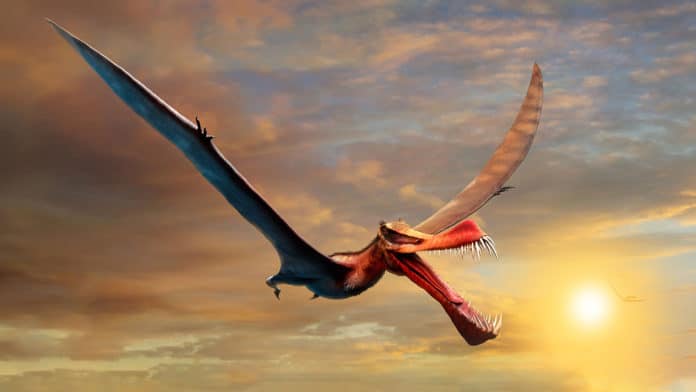Scientists from the University of Queensland have discovered pterosaur’s jaw on Wanamara Country, near Richmond in North West Queensland. This pterosaur, named Thapunngaka shawi, is believed to be Australia’s largest flying reptile.
The pterosaur had around a seven-meter wingspan. According to scientists, it must have soared like a dragon above the ancient, vast inland sea.
The analysis revealed that the Thapunngaka shawi belonged to a group of pterosaurs known as anhanguerians. They had thin-walled and relatively hollow bones.
Tim Richards, from the Dinosaur Lab in UQ’s School of Biological Sciences, said, “It’s the closest thing we have to a real-life dragon. The new pterosaur with a spear-like mouth and a wingspan around seven meters.”
“It was essentially just a skull with a long neck, bolted on a pair of long wings. This thing would have been quite savage.”
“Earlier, it would have cast a great shadow over some quivering little dinosaurs who wouldn’t have heard them coming until it was too late.”
“The skull alone would have been just over one meter long, containing around 40 teeth, perfectly suited to grasping the large predatory fishes known to inhabit Queensland’s no-longer-existent Eromanga Sea. Even though pterosaurs could fly, they were nothing like birds or even bats.”
“Given these adaptations, their fossilized remains are rare and often poorly preserved. It’s quite amazing fossils of these animals exist at all.”
“By world standards, the Australian pterosaur record is poor, but the discovery of Thapunngaka contributes greatly to our understanding of Australian pterosaur diversity.”
Dr. Steve Salisbury, the co-author on the paper and Mr. Richard’s Ph.D. supervisor, said, “what was particularly striking about this new species of anhanguerian was the massive size of the bony crest on its lower jaw, which it presumably had on the upper jaw as well.”
“These crests probably played a role in the flight dynamics of these creatures, and hopefully, future research will deliver more definitive answers.”
Journal Reference:
- Timothy M. Richards et al. A new species of crested pterosaur (Pterodactyloidea, Anhangueridae) from the Lower Cretaceous (upper Albian) of Richmond, North West Queensland, Australia. Journal of Vertebrate Paleontology. DOI: 10.1080/02724634.2021.1946068
